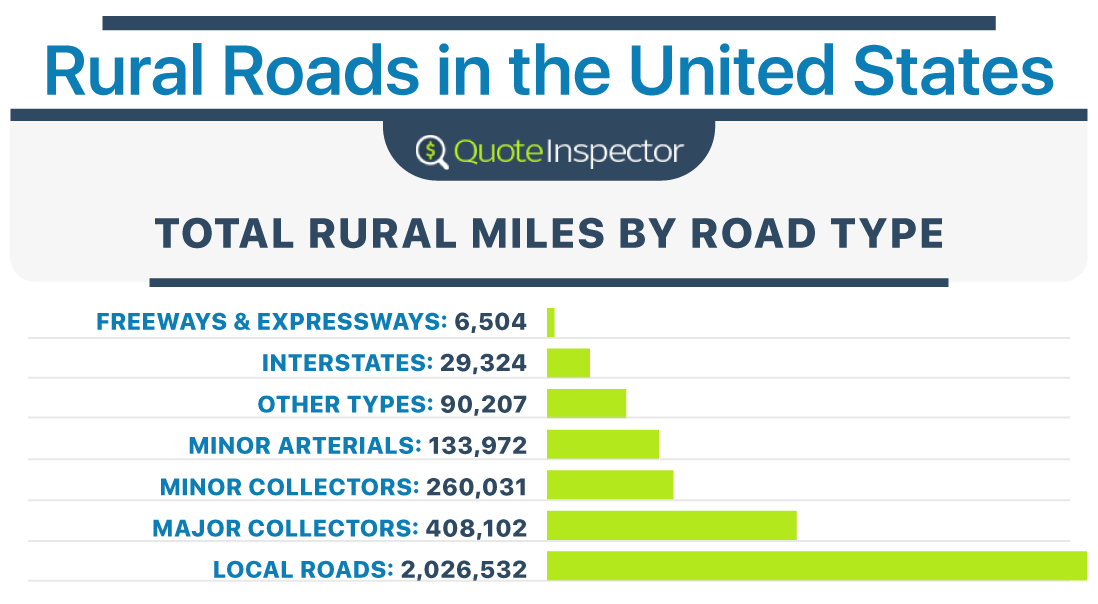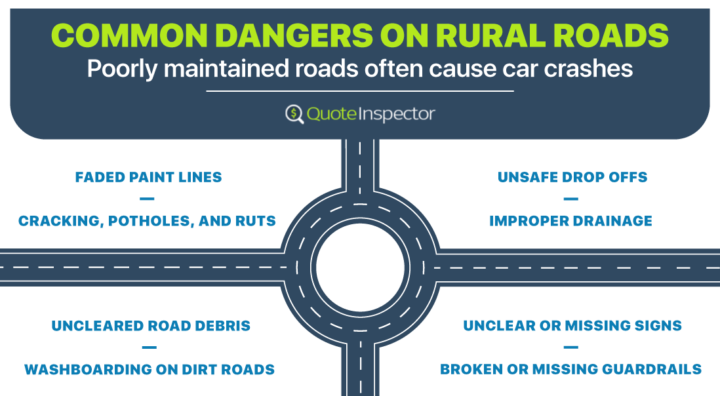States with the Worst Rural Roads in 2025
Enter your zip code below to view companies that have cheap auto insurance rates.
UPDATED: Jun 6, 2023
It’s all about you. We want to help you make the right coverage choices.
Advertiser Disclosure: We strive to help you make confident car insurance decisions. Comparison shopping should be easy. We are not affiliated with any one car insurance provider and cannot guarantee quotes from any single provider.
Our insurance industry partnerships don’t influence our content. Our opinions are our own. To compare quotes from many different companies please enter your ZIP code on this page to use the free quote tool. The more quotes you compare, the more chances to save.
Editorial Guidelines: We are a free online resource for anyone interested in learning more about auto insurance. Our goal is to be an objective, third-party resource for everything auto insurance related. We update our site regularly, and all content is reviewed by auto insurance experts.
Key Takeaways
- In the top 15 states, the average percentage of rural roads in poor condition is 24 percent
- 70 percent of the United States’ roads are rural, meaning poor-quality roads make up a significant portion of roadways
- Having a high percentage of rural roads in poor condition can lead to increased crashes and fatalities
Who has the worst rural roads in the United States? Road quality by state may not seem like a big deal, but poorly kept roads can lead to an increased number of accidents in the states with the worst rural roads. This article covers the 15 states with the worst rural roads.
While no one likes being inconvenienced by reroutes for road construction, a few minutes extra commute is still better than swerving to avoid a pothole and ending up wrapped around a tree.
Poor rural road quality can also mean you are driving on dusty dirt roads, eroding gravel roads, and a host of other less than desirable driving conditions that can lead to more wear and tear on vehicles and increase the chances of an accident.
If you live in one of the states on our list, researching car insurance by state can help you determine which auto insurance companies have the best coverages and rates that meet your auto insurance needs.
Rural roads can be dangerous for even the safest drivers, and the last thing you want is to end up in an accident and have high repair bills.
Our guide covers what the worst rural roads are in the nation, as well as other key topics like:
- Dangers of poorly kept roads
- Staying safe when driving on rural roads
We’ll also cover which state has the best roads, which is the worst state for potholes, what state has the worst drivers, and the worst city roads in America.
Each state with the worst rural roads faces spending a significant amount of time and money to repair their roads and reduce accidents.
Accidents can cause your auto insurance rates to rise, even if poorly-conditioned roads caused the accident. Fortunately, there are ways you can save on car insurance even if you live in one of these states.
If you are looking for the best insurance to cover accidents on poorly maintained roads, enter your ZIP code into our free online quote comparison tool to compare auto insurance quotes from different auto insurance companies and save money today.
Read on to see why each state is among the top 15 states with the worst rural roads in America.
15 States with the Worst Rural Roads
To find the top 15 states with the highest percentages of rural roads in poor condition, our researchers pulled data from TRIP, a national transportation research nonprofit organization. Data from TRIP’s most recent study on rural roads showed which states have the worst rural roads in America.
Because several states were tied for positions based on just poor rural road data, our researchers broke the ties by looking at which states had the highest percentage of rural roads in good condition.
The more rural roads that were in good repair, the further down the list a state was placed, even if it was tied for other states with the percentage of rural roads in poor condition, as the overall condition of its roads will be better than states with lower percentages of good rural roads.
Road Ratings for the States with the Worst Rural Roads| Rank | State | Poor | Fair | Good |
|---|---|---|---|---|
| 1 | Rhode Island | 41% | 39% | 20% |
| 2 | Oklahoma | 36% | 35% | 29% |
| 3 | Hawaii | 32% | 45% | 23% |
| 4 | West Virginia | 29% | 45% | 26% |
| 5 | New Mexico | 28% | 36% | 37% |
| 6 | Arkansas | 26% | 41% | 33% |
| 7 | Connecticut | 24% | 51% | 25% |
| 8 | Mississippi | 24% | 44% | 32% |
| 9 | Alaska | 23% | 33% | 44% |
| 10 | Washington | 21% | 51% | 28% |
| 11 | Missouri | 21% | 47% | 32% |
| 12 | California | 21% | 41% | 38% |
| 13 | Maine | 21% | 36% | 43% |
| 14 | New Hampshire | 20% | 30% | 50% |
| 15 | Louisiana | 19% | 39% | 43% |
What is the most dangerous state to drive in? Rhode Island has the highest percentage of rural roads in poor condition, making it one of the top states with the worst roads.
Read on to see why each state has made the list of the worst states to drive through and learn what actions some states are taking to repair their rural roads.
#15 – Louisiana
- Percentage of Poor Rural Roads: 19%
- State Miles of Rural Roads: 12,961
Louisiana comes in 15th with a total of 19 percent of its rural roads in poor condition. Since the U.S. state average of rural roads in poor condition is 13 percent, Louisiana is well above the national average. Its rural bridges need repair, with 15 percent in poor condition and structurally deficient.
The good news is that in 2019, the Office of the Governor reported that a $700 million bill for road infrastructure repairs and new roads was passed.
While it will take a few years for construction to begin and even longer for repairs to be finished, Louisiana may move off the list of worst rural roads in a decade if the bill works as it is supposed to.
#14 – New Hampshire
- Percentage of Poor Roads: 20%
- State Miles of Rural Roads: 3,186
New Hampshire has 20 percent of its rural roads in poor condition. Nine percent of its rural bridges are also in poor condition, which means that if you drive in rural areas in New Hampshire, 29 percent will be in poor repair.
In 2019, the New Hampshire Department of Transportation (NHDOT) stated in its financial report that its highways’ maintenance cost $51.8 million. Maintenance included patching roads, reconstruction of roads and shoulders, and new guardrails, among other things.
Despite this money poured into New Hampshire’s road repairs and maintenance, the state still has enough rural roads in poor condition to place as 14th on our list. So make sure you have good New Hampshire car insurance in case the rural road conditions cause a collision.
Free Auto Insurance Comparison
Enter your zip code below to view companies that have cheap auto insurance rates.
Secured with SHA-256 Encryption
#13 – Maine
- Percentage of Poor Roads: 21%
- State Miles of Rural Roads: 7,332
Maine is tied with a few other states at 21 percent of rural roads in poor condition. It also has 13 percent of rural bridges in poor condition, putting even more strain on the rural road repair budget.
Like other states, Maine is attempting to repair its roads but is facing challenges with cut budgets due to decreased traffic during COVID. According to NewsCenterMaine, the Maine DOT took an estimated $40 million less than expected in 2020. The result? It may be a while before Maine residents see improvements on rural roads.
#12 – California
- Percentage of Poor Roads: 21%
- State Miles of Rural Roads: 10,259
The bustling state of California has a high percentage of rural roads in poor repair. Some of California’s rural bridges are also in poor repair, as 9 percent are structurally deficient.
According to the California Legislative Analyst Office report on the budget plan, $2 billion was allotted to highway and bridge maintenance and repairs from 2019 to 2020.
However, California will need to put more money into the roads and bridges to reduce the number of roads and bridges in poor repair. The bad news is this usually means California residents have to spend more in taxes to fund road repairs.
California also has a number of other transportation problems to worry about, as two of its cities made our researchers’ list of the worst traffic by cities. In cities with traffic issues, it is even more important to keep the rural roads connecting to cities in good condition.
#11 – Missouri
- Percentage of Poor Roads: 21%
- State Miles of Rural Roads: 30,753
Missouri has 21 percent of its rural roads in poor condition and 9 percent of its rural roads in poor condition. This means that if you drive in a rural area in Missouri, 30 percent of the rural structures and roads will be in poor condition, increasing your risk of road-related incidents.
According to the Missouri DOT’s (MODOT) 2019 financial report, a total of $942 million was spent on construction projects, while $222 million was spent on road repairs, sealings, and stripping.
With so many roads in poor condition, however, the MoDOT will have to pay a lot more for construction and maintenance repairs to lower its percentage of roads in poor condition.
#10 – Washington
- Percentage of Poor Roads: 21%
- State Miles of Rural Roads: 5,512
In Washington, 21 percent of its rural roads are in poor condition. Also, 5 percent of Washington’s rural roads are falling apart and need major structural repairs.
While a huge construction bill was passed in 2019, the Washington DOT (WSDOT) has faced a series of setbacks on its 130 construction projects due to COVID.
Not only has construction had to be shut down on some projects, but decreased traffic from the COVID pandemic means that the WS DOT is earning less revenue from tolls that goes to repairs. Thus, it may be a while before drivers in Washington State see improvements on rural roads.
#9 – Alaska
- Percentage of Poor Roads: 23%
- State Miles of Rural Roads: 4,949
Because Alaska itself is a rural state, most of the roads are rural. This means that 23 percent of rural roads in poor condition is a serious issue. Alaska also has 9 percent of its bridges in poor condition, putting an even further strain on the repair budget.
Unfortunately, Alaska’s weather means keeping up with road repairs and structures can be an expensive and time-consuming task. Heavy snowfall melts can cause soil erosion under bridges and create gaping potholes or cracks on roads.
Not only will these conditions put more wear and tear on Alaska residents’ vehicles, but it could also raise the cost of Alaska car insurance if residents live in an area with particularly bad roads.
Free Auto Insurance Comparison
Enter your zip code below to view companies that have cheap auto insurance rates.
Secured with SHA-256 Encryption
#8 – Mississippi
- Percentage of Poor Roads: 24%
- State Miles of Rural Roads: 9,521
Mississippi is tied with Connecticut, with 24 percent of its rural roads in poor repair. However, because Mississippi has 32 percent of rural roads in good condition, it is slightly better off than Connecticut and earns the eighth spot on our ranking.
Nine percent of Mississippi’s rural bridges are also falling apart, putting even more strain on the local government to fix its rural road and bridges. While the cost to fix and maintain Mississippi’s roads and bridges will be pricy, the conditions of Mississippi’s roads have made repairs a priority of Mississippi’s DOT.
#7 – Connecticut
- Percentage of Poor Roads: 24%
- State Miles of Rural Roads: 1,170
Connecticut also has 24 percent of its rural roads in poor condition, exacerbated by 6 percent of rural bridges falling apart. Because it only has 25 percent of its rural roads in good condition, it earned the seventh spot on our list.
As with many states, Connecticut may face a series of setbacks in its construction and repair projects due to lower revenue in 2020 due to decreased traffic.
Connecticut also doesn’t charge tolls on its highways, which means there is less funding for road repairs.
#6 – Arkansas
- Percentage of Poor Roads: 26%
- State Miles of Rural Roads: 14,113
Arkansas has 26 percent of its rural roads in poor condition and 5 percent of its rural bridges. The state government proposed a new plan that will raise $415 million annually for road repairs and upkeep.
About $1 billion currently goes to upkeeping and maintaining Arkansas’ roads, but any additional funds will be welcomed to improve Arkansas’ rural roads.
#5 – New Mexico
- Percentage of Poor Roads: 28%
- State Miles of Rural Roads: 10,959
New Mexico comes in 5th place with 28 percent of its rural roads in poor condition and 6 percent of rural bridges. Unfortunately, spending on road repairs and maintenance has taken a huge hit. Despite optimistic budget plans at the beginning of 2020, the New Mexico DOT has suffered losses in revenue.
According to a news report by ENR, in 2020, the state governor cut $50 million from the transportation budget. This left just $180 million in 2020 for road construction and repairs.
Because New Mexico has so many rural roads in poor repair, $180 million won’t stretch too far when fixing the rural roads falling apart in the state.
#4 – West Virginia
- Percentage of Poor Roads: 29%
- State Miles of Rural Roads: 30,426
West Virginia is fourth on the list, as it has 29 percent of rural roads in poor condition. A high number of rural bridges are also in poor repair, as 21 percent are deemed in poor condition.
Despite an increase in the state’s budget, a report from Metro News shows that West Virginia is still struggling to make the necessary road repairs and maintain road conditions. Some speculate that not enough money and effort are being put into repairing rural roads due to poor management.
To fix West Virginia’s roads, additional funds would need to be put into the transportation budget, and there would have to be a more concentrated effort on fixing rural roads.
#3 – Hawaii
- Percentage of Poor Roads: 32%
- State Miles of Rural Roads: 483
Hawaii earns the third spot on the list, as 32 percent of its rural roads are in poor condition and 9 percent of its rural bridges.
However, fixes for Hawaii’s rural roads may have to wait, as a recent news report from the Hawaii Tribune-Herald shared that the estimated cost for road repairs after a volcanic eruption will cost Hawaii $82 million. The repairs for the volcano-destroyed roads may set back Hawaii’s other construction projects.
Free Auto Insurance Comparison
Enter your zip code below to view companies that have cheap auto insurance rates.
Secured with SHA-256 Encryption
#2 – Oklahoma
- Percentage of Poor Roads: 36%
- State Miles of Rural Roads: 10,844
Oklahoma wins the second spot for the state with the worst rural roads in America, as it has 36 percent of its rural roads in poor condition. Eleven percent of its rural bridges are also falling apart.
According to Oklahoma’s Office of Management and Enterprise (OME) 2019 budget report, $362.5 million was spent on highways’ construction, maintenance, and repairs.
This amount ate up 18 percent of the State of Oklahoma’s financial budget in 2019. Despite the amount spent on Oklahoma’s roads, however, Oklahoma’s rural roads are still in desperate need of repairs.
#1 – Rhode Island
- Percentage of Poor Roads: 41%
- State Miles of Rural Roads: 374
So what state has the worst roads in 2020? Rhode Island tops the list as the number one state for rural roads in poor condition. In addition to the 41 percent of rural roads in poor condition, Rhode Island also has 22 percent of its rural bridges in poor condition.
Rhode Island will have to devote a significant amount of time and money to fix its rural roads because it is the state with the worst roads in rural areas in the entire country.
If you live in Rhode Island, you may also have higher rates for Rhode Island car insurance. Why? There is a higher chance you will have to file a claim after blowing out a tire on a pothole and ruining your car’s alignment.
Dangers of Rural Roads in Poor Condition
Roads in poor condition are not only a nuisance to drivers, but they can be dangerous as well. Increased accidents and fatalities result from poorly maintained rural roads and increased vehicle costs, longer routes, and other inconveniences.
Rural roads make up 70 percent of roads in the United States, so letting rural roads fall into disarray is an important issue.
The average percentage of rural roads in states is 20.7 percent, although some states have much higher rural road percentages. The interactive state map below shows how many rural roads are in every state, so you can see just how important it is to keep rural roads in good repair.
The states with the highest percentage of rural roads are West Virginia, Virginia, North Carolina, and Delaware. Luckily, only West Virginia made our list of the states with the worst rural roads, so the other states seem to be doing a good job maintaining their rural roads.
Do you know what counts as a rural road in a state? Rural roads make up many different roadways, creating a vast network of roadways in most states. The table below explains the different types of rural roads you may see in your state.
Rural Road Names & Purposes| Rural Road Type | Road Function |
|---|---|
| Freeway/Expressway | Highway with restricted access |
| Interstate | Highway with multiple access points |
| Other | Private roads |
| Minor Arterial | High traffic road that is not a highway or freeway |
| Major Collector | High traffic road that collects/connects local traffic to major roads |
| Minor Collector | Road that collects local traffic and connects it to major roads |
| Local | Neighborhood roads surrounding properties |
While most people associate rural roads with back roads, a rural road doesn’t just mean a winding back road through trees.
A multitude of highways, high traffic roads, and local roads can all be labeled as rural roads.
To give you an idea of the popularity of the different types of rural roads, look at the graphic below.
Local roads make up the greatest number of rural roads in the country, followed by major collector roads. While freeways and expressways only have 6,504 miles of roadway in the country, these high traffic roads are still vital to the U.S. network of roads, as are interstates.
Letting high traffic roads like freeways and interstates fall into disarray could seriously impact traffic patterns and cause multiple accidents.
What do poorly maintained roads look like for the states’ worst rural roads? Take a look at the graphic below to see what main issues arise on poorly maintained rural roads.
While most of the terms on this list are self-explanatory, washboarding is a term that not all drivers are familiar with, as it is a road condition that only happens on unpaved roads with high volumes of traffic. Washboarding is very distinct, as the road looks like there is a series of rippling waves across the surface.
Any one of these issues can contribute to an accident, which is why states must keep up with road repairs and maintenance on rural roads. Otherwise, states may see increased fatalities caused by potholes, missing signs, and other rural road issues.
Free Auto Insurance Comparison
Enter your zip code below to view companies that have cheap auto insurance rates.
Secured with SHA-256 Encryption
Attorneys & Vehicle Experts Speak Up on Dangerous Roads
So, what safety tips should you follow on rural roads? What should you do if poor rural road conditions cause you to crash? We collected advice on these issues from multiple experts, ranging from experienced lawyers to business professionals to travel experts. Read on to see what they have to say about poor rural road conditions.
“Rural Road Defects: Your Options After an Accident
A lot of care and attention must go into designing and maintaining roadways across the United States. Unfortunately, a lot of the focus is on city roads, not rural ones.
In turn, we see many accidents caused by defectively designed roads and dangerous road conditions in more sparsely populated areas of the country.
Physical Road Defects and Dangers
Road defects include much more than potholes and standing water. Uneven road surfaces, a buildup of debris — including tree limbs and trash, and inadequate lighting on a highway — are all factors that can lead to a collision.
Design Road Defects and Dangers
The use of sub-par materials can lead to rapid degradation and breakage of a road surface, making it difficult for tires to grip the road surface.
If signs aren’t placed properly, or signage is allowed to become obscured by overgrown branches and vegetation, drivers won’t have the information they need to drive safely — and that can lead to an accident.
The way some rural roads are designed is simply dangerous, considering the high speeds at which drivers might approach a curve in the road. If the curve is too sharp, the vehicle might roll over or drive right off the road surface.
What to Do After an Accident
If a driver is involved in a road defect car accident, there are three important steps to take.
- Step #1 – Report the accident immediately. A police report and a preliminary investigation can help to preserve relevant evidence.
- Step #2 – Seek medical attention. Documenting injuries will be instrumental if the victim intends to file an injury claim.
- Step #3 – Call a lawyer, preferably a personal injury attorney who has the experience and knowledge necessary to litigate a road defect claim against a government agency. Thanks to sovereign immunity, the government is usually immune from liability in civil lawsuits.
However, there are exceptions — including when governmental negligence contributes to an accident. For instance, if the governmental body responsible for road design and maintenance knew or should have known about a defect or hazard and did nothing to fix it, it can potentially be on the hook for damages should an accident happen.”
Mark Roman, a founding partner of Roman & Gaynor, is a personal injury attorney.
In his 34 years as a lawyer, Mark has recovered millions of dollars for traffic accident victims.
“Road Defects & Poor Road Design
Rural roads don’t always get the attention and care that roads in larger urban cities like Houston receive. So, it’s not uncommon for road defects — potholes, uneven road surfaces, overgrown foliage covering road signs — to exist.
And, rural roadways don’t always benefit from the best designs — many have sharp twists and turns, making it easy for cars to flip, roll over, or effectively sail off the highway.
These road defects can and do cause car accidents.
Liability for a Road Defect Accident
If someone is involved in a crash that was caused, at least in part, by a road defect, it is important to call an attorney with extensive experience handling civil claims involving government entities.
Why? When a road defect factors into an accident, the government agency responsible for designing and maintaining that road can be financially liable for damages. That might be a small town or even the state.
Claims Involving the Government Are Often Challenging
Road defect cases are tough, especially in the state of Texas, where the laws are narrowly tailored to limit the instances in which a lawsuit against the government can be successful.
Having an experienced personal injury lawyer take the lead can be massively helpful in not only winning a road defect case but walking away with a sizable financial award.”
Brian White is the founding partner of Attorney Brian White & Associates.
He is a board-certified personal injury lawyer with over 18 years of experience.
“The only thing connecting drivers and their vehicles to the road is tires. Maintaining your tires is a critical part of road safety.
Additionally, given the poor state of our nation’s infrastructure, many drivers are finding themselves on extremely rough roads within city limits.
Here are three quick tips for maintaining tires to help ensure safety on the road:
Check Tire Inflation Pressure
Tire pressure plays a critical role in your tires’ overall performance, and proper inflation allows drivers better control on the road and helps tires wear longer and more evenly.
Check your tire pressure using a tire pressure gauge and ensure the pressure in each tire — including your spare — matches the ideal tire pressure for your vehicle, which is listed on the sticker inside your car door, glove box or fuel door, or in the car’s manual.
Inspect the Tread Depth
Proper tread depth helps tires maintain traction, improves handling, and prevents hydroplaning. Drivers can check this by inserting the edge of a penny into the tread, with Lincoln going in headfirst.
If the top of Lincoln’s head is covered, there is an acceptable amount of tread; if the top of his head is visible, then it’s time to replace the tire.
Check the Overall Condition
Damaged tires can shorten tire life or cause air loss. Look for cuts, cracks, splits, punctures, or bulges on the exterior of the tire. If any of these conditions are spotted, or if you are unsure of the condition of your tires, visit a tire dealer for a professional inspection.”
Andrea Berryman is the Director of Product Management for Cooper Tire.
She leads the development team, ensuring their tires safely tackle rural roads.
Rural Road Defects: Your Options After an Accident
“If you’re involved in an accident on a rural road, there are a few things you should do. First, assess the damage to your vehicle and yourself. If you can, move your vehicle to the side of the road and, if necessary, call the police. Third, exchange insurance information with the other driver. Lastly, take pictures of the accident scene.
If you believe that a defect in the road caused the accident, you have a few options. You can file a claim with your insurance company, file a lawsuit against the responsible party, or try to negotiate a settlement with the responsible party.
If you choose to file an insurance claim, be aware that your rates may increase if you’re found at fault for the accident. If you decide to file a lawsuit, you’ll need to prove that the road defect was the cause of the accident and that it was not due to driver error.
This can be difficult to do without an experienced attorney. If you choose to negotiate a settlement with the responsible party, you may be able to get them to pay for repairs to your vehicle and any medical bills you incurred as a result of the accident.
No matter what option you choose, make sure you keep all documentation related to the accident, including pictures, police reports, and insurance information.”
What to Do After a Car Accident Caused by a Road Defect
“If you’ve been in a car accident caused by a road defect, there are a few things you should do to ensure your safety and the safety of those around you. First, move your car to the side of the road or a safe location away from traffic. Then, check yourself and your passengers for injuries. If anyone is injured, call 911 immediately.
Once you’ve ensured everyone is safe, you can gather information about the accident. Take photos of the scene, including any damage to your car and the road defect that caused the accident. Get the contact information of any witnesses who saw the accident happen. And be sure to exchange insurance information with the other driver involved.
After you’ve taken care of the immediate aftermath of the accident, there are a few more steps you should take. First, contact your insurance company to report the accident and start the claims process. Then, reach out to a personal injury attorney to discuss your legal options and whether you may be entitled to compensation for your injuries or damages.”
Al Lijee is the founder of AutoLocksmiths.com.
His site provides quotes for vehicle lock and key technicians.
“I own a pest control company, and nearly every day before my technicians head out for the day, they are talking amongst themselves of how horrible their drives were because of the roads.
We are based in Tulsa, Oklahoma. Seemingly a major city would have funding for fixing their roads, but just about every one of the rural roads here is a road surrounded by farmland. This means dirt, gravel, and mud, given the conditions sometimes.
To start off, the roads here are horrible on our company vehicles. Rocks flying nonstop to the underbody of our trucks and prolonged braking times when stopping on a frictionless surface are just a few of the wear and tear issues that we face often.
Also, you will not know chaos until you see a dirt road frozen over.
This is why we have enacted our own driving safety program for our district. Our program is specific to the conditions we face in our region and has greatly improved our incident and near-miss rate.
In the case of an accident or incident, though, we do contact the police, and as from cases in the past — an accident report is written up.
When it comes to the repairs, though, our fleet insurance company here is very familiar with the conditions, and that is all taken into account when our rates were decided.
Sometimes these roads are redone to give them a more even and smoother surface, but when they get really bad, it is up to the state to repair them.
Because of this, all of our employees are familiar with our state’s action center and are often submitting complaints of poorly maintained roads or roads with excess damage to them.”
Andrew Cunningham is the founder of DailyPest.
His commercial drivers cover over 1,500 miles on the road each week.
“The truth is that unsafe roads are far more dangerous than many assume. Sure, they can wreck your car, but that is all fixable. What is scarier is that they can cause harm to people’s health and lives.
With the temperatures in some states dropping and forecast promises of snow and icy roads, it is extremely important to check what roads we’ll be driving on before we embark on our journey.
Make sure you have changed your tires and that your vehicle is ready for the winter season. Prevention is always the best practice.
However, if you do find yourself in a situation where the state of the road caused damage, it is possible to sue the state.
It is a lengthy process, but I know of roads that have been fixed because of such legal action being taken by the victims. I would recommend talking to a legal advisor if that is the case.
Other dangers that lie with bad roads usually involve the lack of lighting. Make sure your vehicle’s lights are checked regularly.
As you may have figured, consistently driving on poor roads will inevitably lead to a poorer state of your car. Sooner or later, this will lead to more frequent visits to the garage and potentially more expensive insurance.
There isn’t always a correlation between the state of the road and the insurance price. However, you may find that in some states or regions, that is taken into account.
Equip your car with higher quality parts than you would have done otherwise. This always makes sense, but it will save you even more money in the long term. Look for off-road vehicles and suitable parts for them. Always ensure your headlights are working before driving at night as well.”
Shayne Sherman is a vehicle expert and the CEO of Car Passionate.
His site provides maintenance advice, repair how-tos, and car part reviews.
“The state of rural roads in this country is abysmal. There are few states that I would say truly have ‘good’ roads.
In my experience, New Jersey, California, and South Dakota have particularly poor road conditions. Especially in the winter, these poor conditions are made exponentially worse year over year by salting roads (which cracks them) and heavy rains.
There are some tips that I use when driving on rural roads that have helped me keep my car (and my sanity) intact.
The first is that if there’s no one else coming from the opposite direction that you can see, turn on your bright lights. They are massively more powerful than your regular beams, and they make seeing potholes and large dips in the road much easier.
Another tip that I have is to slow down. In any situation, speeding may get you there faster, but it can be catastrophic to you and anyone riding with you. Mix wildlife and poor rural roads, and you have a recipe for disaster.
Consistently driving in rural conditions does take its toll on your vehicle. Riding on uneven surfaces and bouncing through potholes obviously takes its toll on tires (it can reduce their tread dramatically).
It can also unbalance your wheels or take them out of alignment, which can be costly. Wheels have to be professionally balanced, and while it’s not the most expensive car repair, it is a nuisance. It can also damage tie rods and control arms, which are significantly more costly and require more downtime for a vehicle.
Trying to get the government to repair damaged roads is a lot like herding cats. Petitions are the best way to go, and often local governments are more pliable. Park City, Utah, has some of the best roads in the country because they are stripped and paved every single year. If only everyone did that!
I alluded to it earlier, but another potential hazard that drivers face on rural roads is wildlife, especially in the worst states for animal collisions.
In Florida, you might run over an alligator, which is like hitting a massive speed bump at 80 mph, an incredibly easy way to destroy your suspension and potentially your entire vehicle. In the north, there are larger animals like deer and moose.
The most important thing when driving on rural roads is to stay alert and be patient with the road.”
Lindsey Maxwell is the co-founder of Where You Make It, a blog about RV living.
She has traveled to over 30 states in a converted Amazon delivery truck that’s now her home.
“Types of Road Defects
Road defects don’t just exist in urban areas like New York City. Venture outside of a large city, and it’s not uncommon to see roads with precarious structures and designs, overgrown trees blocking important signage, and fixtures like lights and signals that haven’t been tended to in what appears to be ages.
In addition, some rural roadways are unpaved, and others are constructed using inferior materials that degrade quickly.
Any of these things can easily contribute to or cause a motor vehicle accident. Whether an accident involves a single vehicle or multiple cars, the consequences can be quite severe.
What to Do After a Car Accident Caused by a Road Defect
The first thing to do after an accident on a rural roadway is to call the police. An officer will visit the scene, conduct a short investigation, and document relevant information. The officer’s report should include details about what type of obvious road defect contributed to the accident.
Next, get to a hospital and get checked out. Physical injuries need to be documented without allowing too much time to go by. This can be critical in establishing a causal link between the road defect accident and injuries.
Consult an attorney. If a road defect did, in fact, play a role in your car accident, you might have a legitimate claim for damages on your hands. After listening to your story, an attorney can help you understand your options and assess your claim’s strength.
Liability for a Road Defect Accident
Road defects shouldn’t exist. Roads should be designed with care and maintained in the same manner. Unfortunately, many times, rural roadways get the short end of the stick and are ignored by the governmental agency (or agencies) in charge.
When this neglect allows a road defect to arise or exist, this neglect can trigger liability in a civil case. This is true, even though the government is typically immune from civil action. When negligence exists, sovereign immunity can be set aside.
An attorney will identify which government body was charged with caring for the road where an accident happened. That might be a city, a municipality, a county, or even the state.
Then, the lawyer can begin to file a complaint with that government body — accompanied by a formal request for compensation.
Government Claims Are Subject to Short Timeframes
Keep in mind that injury claims involving a government defendant are subject to unique rules and procedures.
Perhaps the most important thing to understand is that the statute of limitation is accelerated — meaning an accident victim may have a matter of weeks, not years, to file a claim for damages. Contacting an attorney immediately after a car accident can help to ensure all claims are filed within the applicable timeframe.”
Craig D. Rosenbaum is a senior founding partner at Rosenbaum & Rosenbaum.
As a personal injury attorney, he has represented traffic accident victims for over 20 years.
Frequently Asked Questions: State Roads & Poor Conditions
In terms of rural roads, we’ve now covered the states with the worst roads, including the top 10 states with the worst roads and which state has the worst roads.
We will now go over some of the most commonly asked questions to clear up anything else you may want to know about the state of rural roads in America.
#1 – What state is known for potholes?
It’s impossible to determine what state has the worst potholes, but some of the states that will have more potholes than most are also the states with the roads in the worst condition.
Some of the top contenders for pothole states will be states with poor weather conditions like snow and rain that wear away at the road and form potholes. Like Louisiana, which has issues with flooding, such states will likely be one of the worst states for potholes.
If you live in one of these states, make sure you look closely at your insurance policy. You don’t want to be asking, “Does car insurance cover tire damage from a pothole?” after you’ve already hit one and your tire is shredded.
#2 – What state has the most dirt roads?
According to the Federal Highway Administration, Kansas has the most unpaved roads. The state of Texas comes in second for the most unpaved roads, which isn’t surprising considering Texas is one of the largest states in the country.
#3 – How fast do you drive on dirt roads?
All state-owned roads have posted speed limits, but it is always better to go slow rather than fast if it is a private dirt road with no posted speed limit. Driving on dirt roads is different than driving on paved roads, so drive cautiously and watch out for ruts or divots in the road.
There may also be visibility issues if you drive too fast and kick up dust if there is no gravel, so take it slow on dirt roads to avoid a collision. If you live in an area with multiple dirt roads and high accident rates, you may want to check out the best and worst vehicles for overall collision losses.
Having a safer vehicle can help keep your rates low and your passengers safer.
#4 – What state has the least amount of roads?
The amount of roadways depends on the size of a state, as states like Texas will have many more roads than small states like Rhode Island. However, according to the Federal Highway Administration data, Hawaii has the least amount of rural and urban public roads.
However, even though Hawaii has the least amount of roads, it has trouble maintaining these roads, as it comes in third for states with the worst rural roads.
#5 – Which state has the best rural roads?
Which U.S. state has the best roads? According to TRIP data, the state of Tennessee has the best roads. Eighty-four percent of Tennessee’s rural roads are in good condition, and only 2 percent are poor. So if you live in Tennessee, you shouldn’t be driving over too many potholes.
#6 – Why are South Carolina roads so bad?
Officials in South Carolina say that the roads have gotten so bad for a simple reason: There just hasn’t been enough funding to keep them repaired and adequate over the last three decades. This may be part of the reason South Carolina is ranked as one of the worst and most dangerous states to drive in seemingly year after year.
#7 – What is the longest state to drive through?
In terms of straight-line distance, Alaska is the longest state to drive through as it is 1,400 miles long, 2,700 miles wide, and has nearly 34,000 miles of coastline.
#8 – What is the most dangerous state to drive in?
The most dangerous states to drive through often correlate with the states that have the worst drivers. For that, South Carolina and New Mexico are frequently ranked as having the worst drivers with some of the highest traffic death rates.
#9 – What is the hardest city to drive in?
Although it’s hard to quantify what “hardest” necessarily means, in the case of traffic, the hardest city to drive in is Los Angeles, which is ranked as the worst city in the United States for traffic and traffic congestion.
#10 – Which state has the most streets?
Texas has the most streets according to ESPN with 630. This is 201 more than the nearest competing state — Califonia with 429 streets.
#11 – What is the most traveled interstate in the US?
The most heavily traveled interstate in the United States is I-5, which runs through the Los Angeles metroplex of Los Angeles, Long Beach, and Santa Ana. Showing just how much travel occurs in that metroplex, I-405 is the 4th-most traveled interstate in the US, running through those same cities.
#12 – What US state has the most fatal car accidents?
Texas, in part because of its size, often has the most fatal car accidents per year, with other big states like Florida and California also having large numbers of fatal car accidents.
When fatal crashes per capita is looked at, South Carolina and New Mexico often have the worst traffic death rates due to careless driving, driving under the influence, speeding, and poor road conditions.
#13 – What city has the most aggressive drivers?
Drivers in New York City have a strong reputation for being aggressive drivers, often cutting people off, honking horns repeatedly, and generally being disrespectful.
#14 – Why are Michigan roads so bad compared to other states?
One theory is that because gas is at such a high price already in Michigan, the government doesn’t have much room to increase the fuel tax, which would create revenue for road repairs.
#15 – What is the scariest road in America?
Highway 666, although it was recently renamed, might cause a little trepidation in drivers.
#16 – Who has the highest gas tax?
California has the highest gas tax of all states at 63 cents per gallon compared with a total gas price of $3.38 per gallon.
#17 – Do potholes ruin cars?
Potholes can do all sorts of damage to cars. They can puncture and cause a tire to blow out, damage the suspension and alignment of the vehicle, even hurt the shocks and struts.
Methodology: Ranking the States with the Worst Rural Roads
Our researchers took data from TRIP’s 2019 road quality by state study on rural road conditions across the United States. Our team pulled data for the states with the highest percentages to formulate our ratings for the states with the most rural roads in the worst repair of rural roads in poor condition.
Calculating ratings based on poor road conditions ensured that only the worst of each state’s rural roads were counted in the ratings. Because some states’ percentages were tied, our researchers pulled the top 15 states rather than the top 10 states, as this made sure that all of the worst states with tied percentages were included.
To break the ties, our researchers looked at the overall percentages of rural roads in good condition. States with higher percentages of roads lacking the need for repairs went lower on our list of rankings, even if they were tied with other states for the percentage of roads with poor conditions.
Breaking the ties this way ensured that the state’s overall rural road conditions were taken into consideration.
Every day, drivers get into accidents caused by poor road conditions. Whether that is from swerving to avoid a pothole or driving down a road with poor signage, poorly conditioned roads can lead to accidents. Often, the states with the worst road conditions end up being the states with the worst road accidents.
This can affect your auto insurance rates. Fortunately, there are many ways to save on auto insurance to combat this.
And whether you live in a state with poorly-conditioned roads or not, saving money on car insurance is a big win for everyone. The best and quickest way to do that is to compare live quotes from different auto insurance companies.
If you are going to be doing a lot of driving on poor rural roads, make sure you have good auto insurance, plug your ZIP code into our free online quote generator to compare insurance quotes and find the best auto insurance rates in your area.
References:
- https://tripnet.org/reports/rural-connections-challenges-and-opportunities-in-americas-heartland-may-2020/
- https://www.nh.gov/dot/media/publications.htm
- https://wsdot.wa.gov/about/construction-covid-19
- https://www.modot.org/modot-annual-report
- https://www.newscentermaine.com/article/news/local/maine-dot-facing-40-million-budget-shortfall-as-it-nears-end-of-road-construction-season/97-55846637-106e-4a4c-8a1e-01b161fd6445
- https://lao.ca.gov/Publications/Report/4098
- https://www.arkansasonline.com/news/2019/feb/12/958m-supports-upkeep-of-roads-20190212/
- https://www.enr.com/articles/48862-building-transportation-projects-cut-from-new-mexico-budget
- https://wvmetronews.com/2019/03/18/why-increased-funding-hasnt-fixed-west-virginias-roads/
- https://www.hawaiitribune-herald.com/2020/03/10/hawaii-news/county-reaches-agreement-with-fema-on-lava-covered-roads/
- https://omes.ok.gov/
Frequently Asked Questions
Which states have been identified as having the worst rural roads in 2023?
The states with the worst rural roads in 2023 are currently determined to be [List of states]. These states have experienced significant deterioration in their rural road infrastructure.
What factors contribute to the poor condition of rural roads in these states?
Several factors contribute to the poor condition of rural roads in these states, including insufficient maintenance and repairs, limited funding for infrastructure improvements, harsh weather conditions, heavy agricultural and industrial traffic, and a lack of investment in modernizing the road network.
How does the poor condition of rural roads impact local communities and economies?
The poor condition of rural roads has detrimental effects on local communities and economies. It leads to increased transportation costs for businesses, longer commute times, limited access to healthcare and emergency services, reduced tourism opportunities, and decreased overall economic productivity in these areas.
What measures are being taken to address the issue of poor rural roads in these states?
State governments and transportation authorities are implementing various measures to address the issue of poor rural roads. These measures include allocating additional funds for road repairs and maintenance, developing long-term infrastructure improvement plans, collaborating with federal agencies to secure grants and funding, and exploring innovative technologies to enhance road durability and efficiency.
How long will it take to improve the condition of rural roads in these states?
The timeline for improving the condition of rural roads in these states varies depending on the extent of the deterioration and the resources available for repairs. It is a long-term process that may take several years or even decades to complete. However, state governments are actively working towards making noticeable improvements in the coming years.
Frequently Asked Questions
- What is a named operator policy?
- Will Geico insure a car not in my name?
- What Is Covered in a Jeep Powertrain Warranty? 2025
- Cheapest Jeep Insurance Rates in 2025
- Do trucks cost more to insure?
- How long does a DUI stay on your record?
- Does the Porsche Club of America offer car insurance?
- View All Coverage Questions
Popular Rate Quotes
- Honda Civic Insurance
- Volkswagen Jetta Insurance
- Honda CR-V Insurance
- Toyota Rav4 Insurance
- Honda Accord Insurance
- Chevrolet Malibu Insurance
- Toyota Prius Insurance
- Toyota Sienna Insurance
- Dodge Ram Insurance
Compare Rates and Save
Find companies with the cheapest rates in your area











